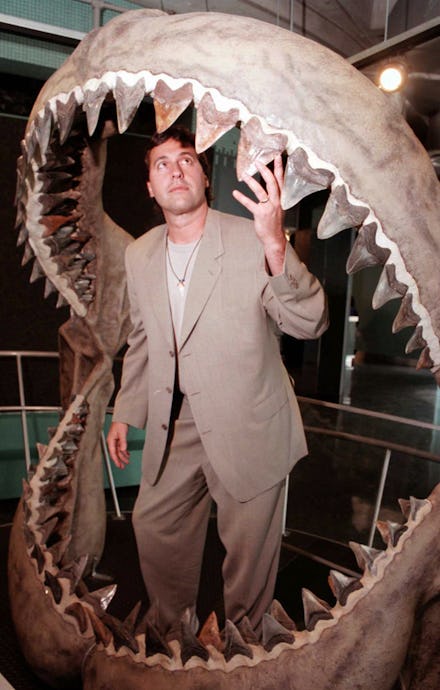6 Extinct Animals That Were Awesomely Bad Ass — Though Admittedly Quite Dangerous

There are plenty of weird and fascinating animals on land and in the oceans today — look no further than the purple frog in India, which actually has this face. However, tracing through our history, we've also missed out on some pretty cool animals that have since gone extinct, be it via natural causes or otherwise.
While we might be grateful that some of these creatures aren't still walking (or swimming; or flying) among us — just for the sake of humans not being eaten alive — these six animals are worth revisiting simple for how magnificently interesting they each were:
Read more: 8 Amazingly Weird-Ass Animals You Never Knew Existed
Tasmanian Tiger: Though the name suggests it's a cat, the Tasmanian Tiger was actually a fairly large marsupial that roamed, you guessed it, Tasmania (as well as Australia and New Guinea). Sadly, the last remaining Tasmanian tigers were wiped out in the 1910s, and the last one in captivity died in native Tasmania in 1936.
The animal had beautiful, tiger-esque stripes over its back — though sadly, this distinct look might have played some part in its extinction, as it was likely a valuable commodity for hunters of the time. Competition for food from animals like dingos also played a role in the Tasmanian tiger's eventual extinction.
Argentavis Magnificens — or big-ass bird: The largest flying bird ever discovered, whose name translates to "magnificent Argentine bird," Argentavis magnificens is believed to have lived in South America around 6 million years ago. It really was big, too, at roughly six feet tall with a 19-to-26-foot wingspan. Interestingly, the shape of the bird's skull suggests that, for the most part, it swallowed its prey whole rather than chewing it.
Still, imagining it roaming the skies now elicits a similar response to that of the folks in Jurassic World when the pterosaurs were let loose.
Giant Lemur: The giant lemur's existence was most recently brought to light in 2015, when scientists discovered an underwater graveyard of the ancient primates' remains in Madagascar. It's likely their extinction coincided with human's inhabiting the formerly isolated African island, with estimates suggesting that the giant primate — which was essentially the size of a gorilla — went extinct in 500 B.C.
"It could have been hunting or habitat modification — for instance, after people introduced cattle to Madagascar and started burning areas for agriculture," Laura Godfrey, a paleontologist and part of the team that discovered the remains, said in an interview with CNN.
Woolly Mammoth: When you think of the Ice Age, chances are two animals come immediately to your mind: the saber-toothed cat and, of course, the woolly mammoth. A relative of the modern African elephant, the woolly mammoth was perfectly tooled for the cold climate, equipped with thick fur to keep them warm. Amazingly, the fur wasn't enough at times to stop wooly mammoth's from freezing to death, which has led to some discoveries of the creatures in good condition.
From this, scientists are hoping to bring the wooly mammoth back to life, in part, by figuring out the order of its DNA. It might not be necessary, but it's science — and admittedly, it's a pretty cool concept.
Dire Wolf: Currently, the most popular dire wolves exist in high fantasy as the proud symbol of House Stark in Game of Thrones. In the series, they are gigantic and powerful creatures who are cuddly to their owners and vicious when provoked or threatened. The awesomeness of the Stark wolves aside, actual dire wolves were pretty interesting in their own right. They were bigger than the modern day grey wolf, and would hunt in especially large packs of as many as 30.
Basically, try and imagine the dire wolves on Thrones hunting in droves, and you can imagine how terrifying it would be to be their prey.
Megalodon: No disrespect to the great white shark, which would be terrifying to encounter in open water as well, but the megalodon is the OG of sharks — or at least the largest shark that existed (that we know of, at least). It could grow to be over 50 feet long, with some scientific estimates putting it at three times the size of a great white. Moreover, their teeth were so big that they were commonly mistaken for "dragon tongues."
With that impressive bit of lore alongside the terrifying skeletal remains of the creature, it's no surprise that it's been featured in several shark-themed B-movies (though, sadly, science has not yet been able to prove its ability to swallow a moving speedboat whole, as per below).